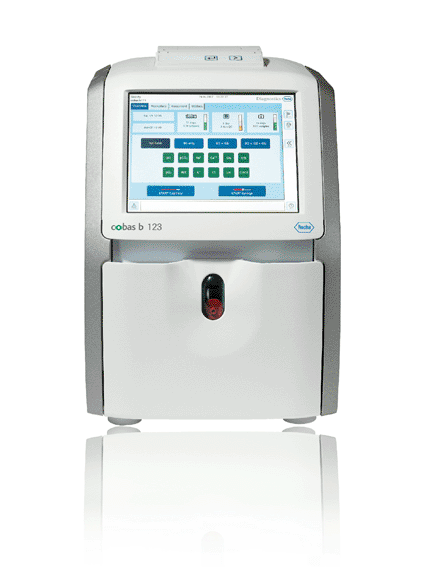Blood Gas Analyzer Focuses on Safety at POC
By LabMedica International staff writers
Posted on 29 Dec 2010
A new blood gas analyzer was designed specifically to be used at the point of care (POC).Posted on 29 Dec 2010
The compact cobas b 123 is ideal for use in critical care units, emergency rooms, and other POC settings. Easy to use and virtually maintenance free, it incorporates a number of important infection control features and ensures minimal downtime with reliable, clot-free operation.

Image: The Roche cobas b 123 blood gas analyzer (photo courtesy Roche).
The only manual maintenance step required for the new instrument is the replacement of consumables.
Its highly durable electronics and mechanics make it robust and reliable, ensuring minimal downtime and saving time required at the machine. Clot-free operation ensures that there is no unnecessary disruption to routine or waste of reagents.
The instrument requires minimal training of staff. With touch screen operation, the system guides the user through operational processes systematically. The press of a single button is all that is required to initiate sampling and measurement.
The new analyzer has many infection control and safety features. There are no exposed needles and the protected sample input area remains closed during operation and between samples. Infection control is further enhanced by the collection of waste in a sealed pack within the closed system. Password authorization ensures safe and appropriate use by locking the instrument to unauthorized/untrained users.
The cobas b 123 includes all important critical care parameters including blood gases, hematocrit, bilirubin, electrolytes, glucose, and lactate. To make interpretation of results as easy as possible, the large, color display screen presents unambiguous readings, with measurements that fall outside predefined acceptable limits highlighted clearly.
The need for scanning barcodes and swapping the consumables across instruments is made redundant by Smart chips on the consumables (sensors, fluid packs, and quality control--QC packs). Because sensors are separate from the fluid pack, the latter can be stored at room temperature. Inventory status is displayed clearly on the screen and step-by-step prompts guide the user through the changing of consumables.
The footprint of the analyzer for environments where there is limited space is reduced by the front loading feature. Data can be transferred across instruments using a simple media card.
The new cobas b 123 POC system is the latest blood gas analyzer from Roche (Basel, Switzerland). It is due to be launched in the UK and Ireland in February 2011.
Dr. Thomas Vering, head of the Roche global sensor program, commented, "Consolidation of important critical care tests on one system allows medical professionals in critical care and emergency settings to obtain rapid answers to a broad range of medical questions. The cobas b 123 is flexible and configurable to accommodate individual needs and with its intuitive operation and excellent connectivity options, it is ideal for use at the point of care.”
Related Links:
Roche













